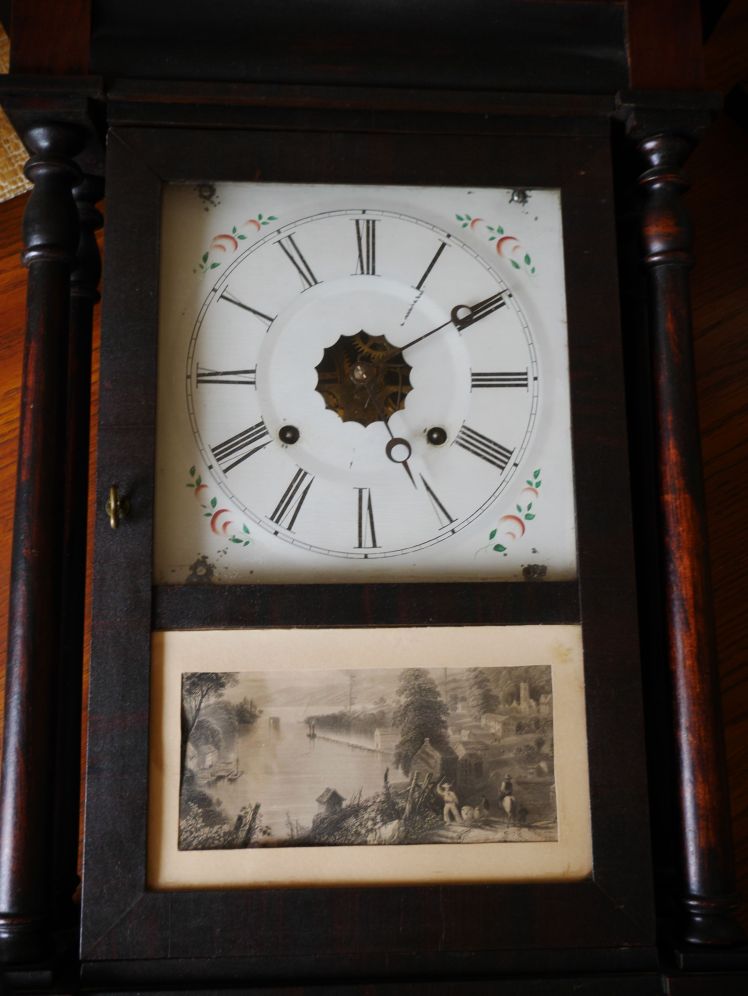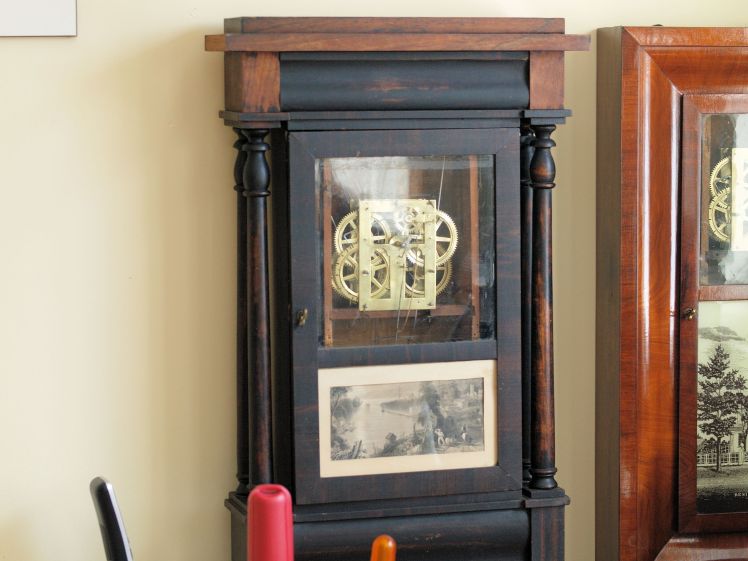I decided that it was time to service this attractive New York-styled Sperry and Shaw 30 hour time and strike, four column hour-strike clock. The case measures 25 1/2 inches in height by 14 inches in width, very close to the dimensions of a typical ogee clock. This clock is an estate auction buy.

The 4 free-standing turned columns drew my attention. It reflects the decorative period of the Empire style popular in the mid 1850s. While researching the NAWCC site I discovered that this clock was probably made between 1846 and 1847. The label, 98% of which is intact, and affixed to the backboard says 10 Courtlandt Street, the company headquarters during the aforementioned period. Sperry and Shaw were not clock-makers but business partners and were regarded as distributors and assemblers.
They sourced cases and movements, affixed their own stamp on the movement and placed their labels (sometimes over other makers labels) inside the case, a common practice at the time as clocks for the home and workplace both locally and abroad were in great demand.
The movement is Jerome-like and stamped Sperry and Shaw, New Jersey. The plates are thinner than a Jerome evidently a cost cutting measure.
The narrow brick-shaped weights (4 3/4 inches X 1 inch) fit neatly into channels on the left and right with little to spare. When I first contacted the seller, he was unsure if the weights were in the clock. He later contacted me to say that the clock indeed had its weights. Had it not come with the weights I would have passed on it because the narrow weights are the only type that will fit into the channels and they would be difficult to source.

The case
The weight cords, though not original, were old and frayed. On the first night I raised the strike weight to the halfway point. Twenty minutes later I heard a loud BANG. When I heard the sound I immediately knew. The cord had snapped and the weight had dropped. Fortunately, there was no damage. I promptly replaced the cords.
I am not sure how I will proceed with the case. The veneer appears to be either mahogany, walnut or rosewood. There are small sections of veneer missing here and there but mostly on the corners, a common issue. It has a two-tone appearance though it is hard to tell if it is the result of aging or the original intent of the maker. There is grime on the darker surfaces and I must decide whether to leave as-is or take it down a little to see what’s there. Attending to the veneer issues on the corners should be a straightforward matter. The break in the right corner of the base is a crude repair and that will have to be redone.


The movement
The movement was disassembled and placed in my L&R ultrasonic cleaner with DEOX-007 solution (7 to 1 ratio) for 30 minutes. The ultrasonic did an terrific job and I am always impressed at how well it cleans lantern pinions. Once the parts were washed in warm water and dried it gave me an opportunity to visually check the movement for obvious issues such as broken or worn teeth, bent arbours and so on. All the parts were in good condition.
The movement had punch marks around every single pivot hole which caused me some concern. However, after pegging the pivot holes and polishing the pivots I re-assembled the movement to check pivot wear and found there were three or four pivots holes that were slightly enlarged but not so much that they had to be done immediately. So, no bushing work this time.
The movement was re-assembled and tested. Unfortunately, my movement stand is not set up for weight driven clocks so testing had to be in the clock case.

I usually test the movement dry for an hour or so before oiling. Why waste clock oil if it must be taken apart again. Once I am satisfied that the movement is running smoothly I take the movement out of its case, oil the pivots and then run it for several days to regulate and to determine if there any minor issues that need to be addressed. Once I am satisfied, the dial and hands are re-attached. With the new weight cords and the movement fully serviced, I tested it for several days.
However, a week later I adjusted the time since it had stopped and the minute hand was disconnected and spinning freely. The main wheel was not communicating with the second wheel because the arbour washer was loose and the resulting wobble meant that the teeth did not engage properly. Out comes the movement to tighten the washer. Now, all is well.
Back to the case. I am still debating what I should do but I may give it a light refresh.

Ron, I think I already gave you my 2 cents on the case, but I’ll repeat them. Many Sperry clocks had very dark almost ebony finishes. A few had labels advertising “Rosewood” finish cases. These were often done in a mix of faux-grained (painted) surfaces, stained mahogany, and rarely ACTUAL rosewood. The cases also tend to have “cheap” cuts of very plain wood (you won’t find crotch mahogany) and often with edge veneers installed in the less attractive long direction (like your chipped side veneer on the base). I would suggest darkening the upper bits (with a mix of stain and diluted paints) and then just adding a low gloss finish (or wax-buffed shellac) to match. I would leave the natural wear on the columns, but if you want a more uniform look, you could lightly mist the areas with an extra dark walnut spray varnish (toner).
LikeLike
I was not planning to do much with the case but your suggestions make good sense.
Ron
LikeLike
Side note: That dial is an Ansonia. They used a very specific sort of angular-edge embossing on their dials. Sperry was well known for using any and all parts from any manufacturer (assuming he’d buy the cheapest goods to maximize profits).
LikeLike
Thanks JC and an interesting detail. The dial may or may not be original but if Sperry and Shaw were looking everywhere for parts, it makes sense.
Ron
LikeLike
I wouldn’t really see any reason to think it’s not original. Usually you can tell by extra holes, shadow lines, and even the patina/witness marks on the back.
LikeLike